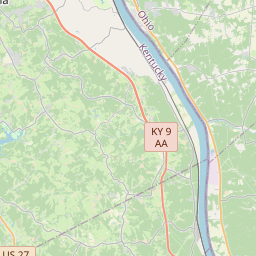Highland United Methodist Church
Historical marker location:






The oldest church congregation in Ft. Thomas. Began in the home of Wm. & Alice Taliaferro in 1830. In 1832, log structure was built for Sunday services & served as first school in the area during the week. 1850-52, frame church building was erected on N. Ft. Thomas Ave. near Holly Lane. In 1900, the present building was built on this site.(Reverse) From 1900-1915, all Highlands High School baccalaureate & graduation services were held in this church. The first kindergarten in the city met here until it moved to Moyer in 1931. At least 148 men and women from the church served in WWII. After Highlands High School burned in 1962, church housed the 7th & 8th grades for rest of year
Kentucky is home to Mammoth Cave National Park, the world's longest known cave system with over 400 miles of explored passages.
During its early history, Campbell County saw significant development due to its prime location along the Ohio River. The county became a hub for transportation and trade, with steamboats and river barges playing a crucial role in its economic growth. The city of Newport, located within Campbell County, became a major port along the Ohio River, attracting businesses and immigrants.
In the mid-19th century, Campbell County experienced rapid industrialization, fueled by the construction of railroads and the establishment of manufacturing industries. The county became known for its ironworks, distilleries, and tobacco warehouses. Newport flourished as a bustling city, becoming a center for entertainment, nightlife, and gambling, earning it the nickname "Sin City."
However, the early 20th century brought challenges to Campbell County. Prohibition, which came into effect in 1919, dealt a blow to the county's flourishing distillery industry. Additionally, the decline of the river trade and the Great Depression impacted the region economically. In the latter half of the 20th century, Campbell County experienced a transformation, with urban development projects and initiatives for economic revival, such as the construction of the Newport on the Levee entertainment complex.
Today, Campbell County continues to evolve as a dynamic community. It is home to a diverse population and offers a mix of suburban and rural areas. The county boasts a rich cultural heritage, historical landmarks, and natural beauty, making it an attractive place to live, work, and visit.
Campbell County Timeline
This timeline provides a glimpse into the major events and milestones that have shaped the history of Campbell County, Kentucky.
- 1795: Campbell County is established from parts of Mason, Scott, and Harrison counties.
- 1803: Newport, the county seat, is incorporated as a town.
- 1823: Campbell County Courthouse is completed in Newport.
- 1837: Burlington, another town in Campbell County, is incorporated.
- 1861-1865: Campbell County residents actively participate in the Civil War.
- 1889: Newport becomes a city.
- 1895: Bellevue, Dayton, and Fort Thomas are incorporated as cities.
- 1926: Campbell County Memorial Bridge is opened, connecting Newport and Cincinnati.
- 1959: Interstate 471 is completed, facilitating transportation through the county.
- 1961: Northern Kentucky University is founded in Highland Heights.
- 1997: Campbell County Historic Preservation Board is established to protect historical sites.
- 2018: Population of Campbell County reaches over 92,000 residents.